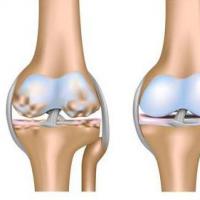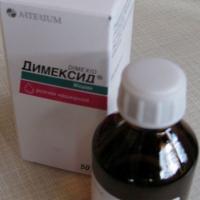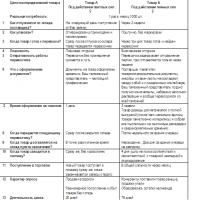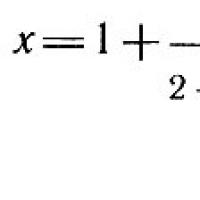A brief history of the appearance of atomic time measuring instruments. How do atomic clocks work?
A sensation has spread around the scientific world - time is evaporating from our Universe! So far this is only a hypothesis of Spanish astrophysicists. But the fact that the flow of time on Earth and in space is different has already been proven by scientists. Time flows slower under the influence of gravity, accelerating as it moves away from the planet. The task of synchronizing earthly and cosmic time is performed by hydrogen frequency standards, which are also called “atomic clocks.”
First atomic time appeared along with the emergence of astronautics, atomic clocks appeared in the mid-20s. Nowadays, atomic clocks have become an everyday thing; each of us uses them every day: digital communications, GLONASS, navigation, and transport operate with their help.
Owners mobile phones they hardly think about what complex work is carried out in space for strict time synchronization, and yet we are talking about only millionths of a second.

The exact time standard is stored in the Moscow region, at the Scientific Institute of Physical-Technical and Radio-Technical Measurements. There are 450 such watches in the world.

Russia and the USA have monopolies on atomic clocks, but in the USA clocks operate on the basis of cesium, a radioactive metal that is very harmful to the environment, and in Russia, on the basis of hydrogen, a safer, durable material.

This watch does not have a dial or hands: it looks like a large barrel of rare and valuable metals, filled with the most advanced technologies - high-precision measuring instruments and equipment with atomic standards. The process of their creation is very long, complex and takes place in conditions of absolute sterility.

For 4 years now, the clock installed on the Russian satellite has been studying dark energy. By human standards, they lose accuracy by 1 second over many millions of years.

Very soon, atomic clocks will be installed on Spektr-M, a space observatory that will see how stars and exoplanets are formed, and will look beyond the edge of the black hole in the center of our Galaxy. According to scientists, due to the monstrous gravity, time flows so slowly here that it almost stops.
tvroscosmos
Atomic clock January 27th, 2016

The birthplace of the world's first pocket watch with a built-in atomic time standard will not be Switzerland or even Japan. The idea of their creation originated in the heart of Great Britain at the London brand Hoptroff
Atomic clocks, or as they are also called “quantum clocks,” are a device that measures time using natural vibrations associated with processes occurring at the level of atoms or molecules. Richard Hoptroff decided that it was time for modern gentlemen who are interested in ultra-technological devices to exchange their mechanical pocket watches for something more extravagant and unconventional, and also in line with modern urban trends.
Thus, the public were shown elegant in their own way appearance pocket atomic clock Hoptroff No. 10, which can surprise the modern generation, sophisticated with an abundance of gadgets, not only with its retro style and fantastic accuracy, but also with its service life. According to the developers, having this watch with you, you can remain the most punctual person for at least 5 billion years.
What else can you find out interesting about them...
Photo 2. 
For all those who have never been interested in such watches, it is worth briefly explaining the principle of their operation. There is nothing inside the “atomic device” that resembles a classic mechanical watch. In Hoptroff no. 10 there are no mechanical parts as such. Instead, atomic pocket watches are equipped with a sealed chamber filled with a radioactive gas, the temperature of which is controlled by a special furnace. Accurate timekeeping occurs as follows: lasers excite the atoms of a chemical element, which is a kind of “filler” of the clock, and the resonator records and measures each atomic transition. Today, the basic element of such devices is cesium. If we recall the SI system of units, then in it the value of a second is related to the number of periods of electromagnetic radiation during the transition of cesium-133 atoms from one energy level to another.
Photo 3. 
If in smartphones the heart of the device is considered to be a processor chip, then in Hoptroff No. 10 this role is taken on by the reference time generator module. It is supplied by Symmetricom, and the chip itself was initially intended for use in the military industry - in unmanned aerial vehicles.
The CSAC atomic clock is equipped with a temperature-controlled thermostat, which contains a chamber containing cesium vapor. Under the influence of a laser on cesium-133 atoms, their transition from one energy state to another begins, which is measured using a microwave resonator. Since 1967, the International System of Units (SI) has defined one second as 9,192,631,770 periods of electromagnetic radiation produced during the transition between two hyperfine levels of the ground state of a cesium-133 atom. Based on this, it is difficult to imagine a more technically accurate cesium-based watch. Over time, given the latest advances in time measurement, the accuracy of new optical clock based on an aluminum ion pulsating at a frequency of ultraviolet radiation (100,000 times higher than the microwave frequencies of cesium clocks), it will hundreds of times exceed the accuracy of atomic chronometers. To put it simply, Hoptroff's new Pocket Model No.10 has a running error of 0.0015 seconds per year, which is 2.4 million times better than COSC standards.
Photo 4. 
The functional side of the device is also on the verge of fantasy. With its help you can find out: time, date, day of the week, year, latitude and longitude in different quantities, pressure, humidity, sidereal hours and minutes, tide forecast and many other indicators. The watch comes in gold, and the case is made from precious metal It is planned to use 3D printing.
Richard Hoptrof sincerely believes that this particular option for producing his brainchild is the most preferable. To slightly change the design component of the structure, it will not be necessary to rebuild the production line at all, but to use the functional flexibility of the 3D printing device for this. However, it is worth noting that the prototype of the watch shown was made in the classical way.
Photo 5. 
Time is very expensive these days, and the Hoptroff No. 10 is a direct confirmation of this. According to preliminary information, the first batch of atomic devices will be 12 units, and as for the cost, the price for 1 copy will be $78,000.
Photo 6. 
According to Richard Hoptroff, managing director of the brand, Hoptroff's London location played a key role in the emergence of this idea. “In our quartz movements we use a high-precision oscillating system with a GPS signal. But in the center of London it is not so easy to catch this very signal. One day, during a trip to the Greenwich Observatory, I saw a Hewlett Packard atomic clock there and decided to buy something similar for myself via the Internet. And I couldn't. Instead, I came across information about a chip from Symmetricon, and after three days of thinking, I realized that it would be perfect for a pocket watch.”
The chip in question is the SA.45s cesium atomic clock (CSAC), one of the first generation of miniature atomic clocks for GPS receivers, backpack radios and unmanned vehicles. Despite its modest dimensions (40 mm x 34.75 mm), the wrist watch It's still unlikely to fit. Therefore, Hoptroff decided to equip them with a pocket model of rather respectable dimensions (82 mm in diameter).
In addition to being the world's most accurate watch, the Hoptroff No 10 (the brand's tenth movement) also claims to be the first gold case made using 3D printing technology. Hoptroff cannot yet say with certainty how much gold will be required to make the case (work on the first prototype was completed when the issue went to press), but estimates that its cost will be “at least several thousand pounds.” And given all that volume scientific research, required to develop the product (take, for example, the function of calculating the ebb and flow of tides using harmonic constants for 3 thousand different ports), we can expect its final retail price to be about 50 thousand pounds sterling.
Gold body of model No. 10 as it comes out of the 3D printer and in finished form
Buyers automatically become members of an exclusive club and will be required to sign a written pledge not to use the atomic clock chip as a weapon. “This is one of the conditions of our contract with the supplier,” explains Mr. Hoptroff, “since the atomic chip was originally used in missile guidance systems.” Not much for the opportunity to have a watch with impeccable accuracy.
The lucky owners of the No.10 from Hoptroff will have much more at their disposal than just a high-precision watch. The model also functions as a pocket navigation device, allowing one to determine longitude with an accuracy of one nautical mile, even after many years at sea, using a simple sextant. The model will receive two dials, but the design of one of them is still kept secret. The other is a whirlwind of counters displaying as many as 28 complications: from all possible chronometric functions and calendar indicators to a compass, thermometer, hygrometer (a device for measuring humidity levels), barometer, latitude and longitude counters and a high/low tide indicator. And this is not to mention the vital indicators of the state of the atomic thermostat.
Hoptroff has plans to produce a number of new products, including electronic version George Daniels' legendary Space Traveler complication. It is currently being worked on to integrate Bluetooth technology into the watch to store the wearer's personal information and enable automatic adjustment of complications such as the moon phase indicator.
The first copies of No.10 will appear in next year, in the meantime, the company is looking for suitable partners among retailers. “We could, of course, try to sell it online, but this is a premium model, so you still need to hold it in your hands to really appreciate it. This means that we will still have to use the services of retailers, and we are ready to start negotiations,” says Mr. Hoptroff in conclusion.
And even The original article is on the website InfoGlaz.rf Link to the article from which this copy was made -
Firstly, mankind uses clocks as a means of program-time control.
Secondly, today the measurement of time is the most accurate type of measurement of all: the accuracy of time measurement is now determined by an incredible error of the order of 1·10-11%, or 1 s in 300 thousand years.
And modern people achieved such accuracy when they began to use atoms, which, as a result of their oscillations, are the regulator of the atomic clock. Cesium atoms are in two energy states we need (+) and (-). Electromagnetic radiation with a frequency of 9,192,631,770 hertz is produced when atoms change from the (+) state to the (-) state, creating a precise, constant periodic process - the regulator of the atomic clock code.
In order for atomic clocks to work accurately, cesium must be evaporated in a furnace, a process that releases its atoms. Behind the furnace there is a sorting magnet, which has the capacity of atoms in the (+) state, and in it, due to irradiation in the microwave field, the atoms go into the (-) state. The second magnet directs the atoms that have changed state (+) to (-) into the receiving device. Many atoms that have changed their state are obtained only if the frequency of the microwave emitter exactly coincides with the cesium vibration frequency of 9,192,631,770 hertz. Otherwise, the number of atoms (-) in the receiving device decreases.
The devices constantly monitor and regulate the constant frequency of 9,192,631,770 hertz. This means that the dream of watch designers has come true, an absolutely constant periodic process has been found: a frequency of 9,192,631,770 hertz, which regulates the course of atomic clocks.
Today, as a result of international agreement, a second is defined as the period of radiation multiplied by 9,192,631,770, corresponding to the transition between two hyperfine structural levels of the ground state of the cesium atom (isotope cesium-133).
To measure precise time, you can also use vibrations of other atoms and molecules, such as atoms of calcium, rubidium, cesium, strontium, hydrogen molecules, iodine, methane, etc. However, the radiation of the cesium atom is recognized as the frequency standard. In order to compare the vibrations of different atoms with a standard (cesium), a titanium-sapphire laser was created that generates a wide range of frequencies in the range from 400 to 1000 nm.
The first creator of quartz and atomic clocks was an English experimental physicist Essen Lewis (1908-1997). In 1955, he created the first atomic frequency (time) standard using a beam of cesium atoms. As a result of this work, 3 years later (1958) a time service based on the atomic frequency standard arose.
In the USSR, Academician Nikolai Gennadievich Basov put forward his ideas for creating an atomic clock.
So, atomic clock, One of the precise types of clocks is a device for measuring time, where the natural vibrations of atoms or molecules are used as a pendulum. The stability of atomic clocks is the best among all existing types of clocks, which is the key to the highest accuracy. The atomic clock generator produces more than 32,768 pulses per second, unlike conventional clocks. Atomic vibrations do not depend on air temperature, vibrations, humidity and many other external factors.
IN modern world, when navigation is simply impossible, atomic clocks have become indispensable assistants. They are capable of determining the location of a spaceship, satellite, ballistic missile, aircraft, submarine, car automatically via satellite communications.
Thus, for the last 50 years, atomic clocks, or rather cesium clocks, have been considered the most accurate. They have long been used by time services, and time signals are also broadcast by some radio stations.
The atomic clock device includes 3 parts: 
quantum discriminator,
quartz oscillator,
electronics complex.
The quartz oscillator generates a frequency (5 or 10 MHz). The oscillator is an RC radio generator, which uses piezoelectric modes of a quartz crystal as a resonant element, where atoms that have changed state (+) to (-) are compared. To increase stability, its frequency is constantly compared with the oscillations of a quantum discriminator (atoms or molecules) . When a difference in oscillation occurs, the electronics adjust the frequency of the quartz oscillator to zero, thereby increasing the stability and accuracy of the watch to the desired level.
In the modern world, atomic clocks can be manufactured in any country in the world for use in Everyday life. They are very small in size and beautiful. The latest atomic clock is no larger than a matchbox and has low power consumption of less than 1 watt. And this is not the limit, perhaps in the future technical progress will reach mobile phones. In the meantime, compact atomic clocks are installed only on strategic missiles to increase navigation accuracy many times over.
Today, men's and women's atomic watches for every taste and budget can be bought in online stores.
 In 2011, the world's smallest atomic clock was created by specialists from Symmetricom and Sandia National Laboratories. This watch is 100 times more compact than previous commercially available versions. The size of an atomic chronometer is no larger than a matchbox. To operate, it only needs 100 mW of power - this is 100 times less compared to its predecessors.
In 2011, the world's smallest atomic clock was created by specialists from Symmetricom and Sandia National Laboratories. This watch is 100 times more compact than previous commercially available versions. The size of an atomic chronometer is no larger than a matchbox. To operate, it only needs 100 mW of power - this is 100 times less compared to its predecessors.
It was possible to reduce the size of the watch by installing instead of springs and gears a mechanism operating on the principle of determining frequency electromagnetic waves, emitted by cesium atoms under the influence of a laser beam of negligible power.
Such clocks are used in navigation, as well as in the work of miners, divers, where it is necessary to accurately synchronize time with colleagues on the surface, as well as precise time services, because the error of atomic clocks is less than 0.000001 fractions of a second per day. The cost of the record small atomic clock Symmetricom was about $1,500.
Which “watchmakers” invented and perfected this extremely precise mechanism? Is there a replacement for him? Let's try to figure it out.
In 2012, atomic timekeeping will celebrate its forty-fifth anniversary. In 1967, the category of time in International system units began to be determined not by astronomical scales, but by the cesium frequency standard. This is what the common people call the atomic clock.
What is the operating principle of atomic oscillators? These “devices” use quantum energy levels of atoms or molecules as a source of resonant frequency. Quantum mechanics connects several discrete energy levels with the “atomic nucleus - electrons” system. An electromagnetic field of a certain frequency can provoke a transition of this system from low level to a higher one. The opposite phenomenon is also possible: an atom can move from a high energy level to a lower one by emitting energy. Both phenomena can be controlled and these energy interlevel jumps can be recorded, thereby creating a semblance of an oscillatory circuit. The resonant frequency of this circuit will be equal to the energy difference between the two transition levels divided by Planck's constant.
The resulting atomic oscillator has undoubted advantages over its astronomical and mechanical predecessors. The resonant frequency of all atoms of the substance chosen for the oscillator will be, unlike pendulums and piezocrystals, the same. In addition, atoms do not wear out or change their properties over time. Ideal for a virtually eternal and extremely precise chronometer.
For the first time, the possibility of using interlevel energy transitions in atoms as a frequency standard was considered back in 1879 by British physicist William Thomson, better known as Lord Kelvin. He proposed using hydrogen as a source of resonator atoms. However, his research was rather theoretical in nature. Science at that time was not yet ready to develop an atomic chronometer.
It took almost a hundred years for Lord Kelvin's idea to come to fruition. It was a long time, but the task was not easy. Transforming atoms into ideal pendulums turned out to be more difficult in practice than in theory. The difficulty lay in the battle with the so-called resonant width - a small fluctuation in the frequency of absorption and emission of energy as atoms move from level to level. The ratio of the resonant frequency to the resonant width determines the quality of the atomic oscillator. Obviously, the larger the value of the resonant width, the lower the quality of the atomic pendulum. Unfortunately, it is not possible to increase the resonant frequency to improve quality. It is constant for the atoms of each specific substance. But the resonant width can be reduced by increasing the time of observation of atoms.
Technically, this can be achieved as follows: let an external, for example quartz, oscillator periodically generate electromagnetic radiation, causing the atoms of the donor substance to jump across energy levels. In this case, the task of the atomic chronograph tuner is to bring the frequency of this quartz oscillator as close as possible to the resonant frequency of the interlevel transition of atoms. This becomes possible in the case of a sufficiently long period of observation of atomic vibrations and the creation feedback, regulating the quartz frequency.
True, in addition to the problem of reducing the resonant width in an atomic chronograph, there are a lot of other problems. This is the Doppler effect - a shift in the resonant frequency due to the movement of atoms, and mutual collisions of atoms, causing unplanned energy transitions, and even the influence of the pervasive energy of dark matter.
The first attempt at the practical implementation of atomic clocks was made in the thirties of the last century by scientists at Columbia University under the leadership of the future Nobel laureate Dr. Isidor Rabi. Rabi proposed using the cesium isotope 133 Cs as a source of pendulum atoms. Unfortunately, Rabi's work, which greatly interested NBS, was interrupted by World War II.
After its completion, the lead in the implementation of the atomic chronograph passed to NBS employee Harold Lyons. His atomic oscillator ran on ammonia and gave an error comparable to the best examples of quartz resonators. In 1949, the ammonia atomic clock was demonstrated to the general public. Despite the rather mediocre accuracy, they implemented the basic principles of future generations of atomic chronographs.
The prototype of a cesium atomic clock obtained by Louis Essen provided an accuracy of 1 * 10 -9, while having a resonance width of only 340 Hertz
A little later, Harvard University professor Norman Ramsey improved Isidor Rabi's ideas, reducing the impact of the Doppler effect on the accuracy of measurements. He proposed, instead of one long high-frequency pulse exciting atoms, to use two short ones sent to the arms of the waveguide at some distance from each other. This made it possible to sharply reduce the resonant width and actually made it possible to create atomic oscillators that are an order of magnitude superior in accuracy to their quartz ancestors.
In the fifties of the last century, based on the scheme proposed by Norman Ramsey, at the National Physical Laboratory (UK), its employee Louis Essen worked on an atomic oscillator based on the cesium isotope 133 Cs previously proposed by Rabi. Cesium was not chosen by chance.
Scheme of hyperfine transition levels of atoms of the cesium-133 isotope
Belonging to the group of alkali metals, cesium atoms are extremely easily excited to jump between energy levels. For example, a beam of light can easily knock out a flow of electrons from the cesium atomic structure. It is due to this property that cesium is widely used in photodetectors.
Design of a classical cesium oscillator based on a Ramsey waveguide
First official cesium frequency standard NBS-1
Descendant of NBS-1 - the NIST-7 oscillator used laser pumping of a beam of cesium atoms
It took more than four years for the Essen prototype to become a true standard. After all, precise adjustment of atomic clocks was possible only by comparison with existing ephemeris units of time. Over the course of four years, the atomic oscillator was calibrated by observing the Moon's rotation around the Earth using a precision lunar camera invented by the US Naval Observatory's William Markowitz.
The "adjustment" of atomic clocks to lunar ephemeris was carried out from 1955 to 1958, after which the device was officially recognized by the NBS as a frequency standard. Moreover, the unprecedented accuracy of cesium atomic clocks prompted NBS to change the unit of time in the SI standard. Since 1958, the second has been officially adopted as “the duration of 9,192,631,770 periods of radiation corresponding to the transition between two hyperfine levels of the standard state of an atom of the cesium-133 isotope.”
Louis Essen's device was named NBS-1 and was considered the first cesium frequency standard.
Over the next thirty years, six modifications of NBS-1 were developed, the latest of which, NIST-7, created in 1993 by replacing magnets with laser traps, provides an accuracy of 5 * 10 -15 with a resonant width of only sixty-two Hertz.
Comparison table of characteristics of cesium frequency standards used by NBS
| Cesium frequency standard | Operating time | Time served as an official NPFS standard | Resonance width | Microwave waveguide length | Error value |
| NBS-1 | 1952-1962 | 1959-1960 | 300 Hz | 55 cm | 1*10 -11 |
| NBS-2 | 1959-1965 | 1960-1963 | 110 Hz | 164 cm | 8*10 -12 |
| NBS-3 | 1959-1970 | 1963-1970 | 48 Hz | 366 cm | 5*10 -13 |
| NBS-4 | 1965-1990s | No | 130 Hz | 52.4 cm | 3*10 -13 |
| NBS-5 | 1966-1974 | 1972-1974 | 45 Hz | 374 cm | 2*10 -13 |
| NBS-6 | 1974-1993 | 1975-1993 | 26 Hz | 374 cm | 8*10 -14 |
| NBS-7 | 1988-2001 | 1993-1998 | 62 Hz | 155 cm | 5*10 -15 |
NBS devices are stationary stands, which allows them to be classified as standards rather than practically used oscillators. But for purely practical purposes, Hewlett-Packard worked for the benefit of the cesium frequency standard. In 1964, the future computer giant created a compact version of the cesium frequency standard - the HP 5060A device.
Calibrated using NBS standards, the HP 5060 frequency standards fit into a typical radio equipment rack and were a commercial success. It was thanks to the cesium frequency standard set by Hewlett-Packard that the unprecedented accuracy of atomic clocks became widespread.
Hewlett-Packard 5060A.
As a result, such things as satellite television and communications, global navigation systems, and information network time synchronization services became possible. There have been many applications for the industrialized atomic chronograph technology. At the same time, Hewlett-Packard did not stop there and is constantly improving the quality of cesium standards and their weight and dimensions.
Hewlett-Packard family of atomic clocks
In 2005, Hewlett-Packard's atomic clock division was sold to Simmetricom.
Along with cesium, the reserves of which in nature are very limited, and the demand for it in a variety of technological fields is extremely high, rubidium, whose properties are very close to cesium, was used as a donor substance.
It would seem that the existing atomic clock scheme has been brought to perfection. Meanwhile, it had an annoying drawback, the elimination of which became possible in the second generation of cesium frequency standards, called cesium fountains.
Fountains of time and optical molasses
Despite the highest accuracy of the NIST-7 atomic chronometer, which uses laser detection of the state of cesium atoms, its design is not fundamentally different from the designs of the first versions of cesium frequency standards.
A design disadvantage of all these schemes is that it is fundamentally impossible to control the speed of propagation of a beam of cesium atoms moving in a waveguide. And this despite the fact that the speed of movement of cesium atoms at room temperature is one hundred meters per second. Very quickly.
That is why all modifications of cesium standards are a search for a balance between the size of the waveguide, which has time to influence fast cesium atoms at two points, and the accuracy of detecting the results of this influence. The smaller the waveguide, the more difficult it is to make successive electromagnetic pulses affecting the same atoms.
What if we find a way to reduce the speed of cesium atoms? It was precisely this thought that preoccupied the Massachusetts student Institute of Technology Jerold Zacharius, who studied the influence of gravity on the behavior of atoms in the late forties of the last century. Later, involved in the development of a variant of the cesium frequency standard Atomichron, Zacharius proposed the idea of a cesium fountain - a method to reduce the speed of cesium atoms to one centimeter per second and get rid of the double-armed waveguide of traditional atomic oscillators.
Zacharius' idea was simple. What if you fired cesium atoms vertically inside an oscillator? Then the same atoms will pass through the detector twice: once while traveling up, and again down, where they will rush under the influence of gravity. In this case, the downward movement of atoms will be significantly slower than their takeoff, because during their journey in the fountain they will lose energy. Unfortunately, in the fifties of the last century, Zacharius was unable to realize his ideas. In his experimental setup, atoms moving upward interacted with those falling downward, which confused the accuracy of detection.
The idea of Zacharius was returned only in the eighties. Scientists at Stanford University, led by Steven Chu, have found a way to realize the Zacharius Fountain using a method they call "optical molasses."
In the Chu cesium fountain, a cloud of cesium atoms fired upward is pre-cooled by a system of three pairs of counter-directed lasers that have a resonant frequency just below the optical resonance of the cesium atoms.
Scheme of a cesium fountain with optical molasses.
The laser-cooled cesium atoms begin to move slowly, as if through molasses. Their speed drops to three meters per second. Reducing the speed of atoms gives researchers the opportunity to more accurately detect states (you must admit that it is much easier to see the license plates of a car moving at a speed of one kilometer per hour than a car moving at a speed of one hundred kilometers per hour).
A ball of cooled cesium atoms is launched upward about a meter, passing a waveguide along the way, through which the atoms are exposed to an electromagnetic field of a resonant frequency. And the detector of the system records the change in the state of atoms for the first time. Having reached the “ceiling”, the cooled atoms begin to fall due to gravity and pass through the waveguide a second time. On the way back, the detector again records their condition. Since the atoms move extremely slowly, their flight in the form of a fairly dense cloud is easy to control, which means that in the fountain there will not be atoms flying up and down at the same time.
Chu's cesium fountain facility was adopted by NBS as a frequency standard in 1998 and named NIST-F1. Its error was 4 * 10 -16, which means that NIST-F1 was more accurate than its predecessor NIST-7.
In fact, NIST-F1 reached the limit of accuracy in measuring the state of cesium atoms. But scientists did not stop at this victory. They decided to eliminate the error that black body radiation introduces into the operation of atomic clocks - the result of the interaction of cesium atoms with the thermal radiation of the body of the installation in which they move. The new NIST-F2 atomic chronograph placed a cesium fountain in a cryogenic chamber, reducing black body radiation to almost zero. The NIST-F2 error is an incredible 3*10 -17.
Graph of error reduction of cesium frequency standard options
Currently, atomic clocks based on cesium fountains provide humanity with the most accurate standard of time, relative to which the pulse of our technogenic civilization beats. Thanks to engineering tricks, the pulsed hydrogen masers that cool cesium atoms in the stationary versions of NIST-F1 and NIST-F2 were replaced with a conventional laser ray, working in tandem with a magneto-optical system. This made it possible to create compact and highly resistant versions of the NIST-Fx standards that can be used in spacecraft. Quite imaginatively called "Aerospace Cold Atom Clock", these frequency standards are installed in the satellites of navigation systems such as GPS, which ensures their amazing synchronization to solve the problem of very accurate calculation of the coordinates of the GPS receivers used in our gadgets.
A compact version of the cesium fountain atomic clock, called the "Aerospace Cold Atom Clock", is used in GPS satellites
The time reference calculation is performed by an "ensemble" of ten NIST-F2s located at various research centers collaborating with the NBS. The exact value of the atomic second is obtained collectively, thereby eliminating various errors and the influence of the human factor.
However, it is possible that one day the cesium frequency standard will be perceived by our descendants as a very crude mechanism for measuring time, just as we now look condescendingly at the movements of the pendulum in the mechanical grandfather clocks of our ancestors.
, Galileo) are impossible without atomic clocks. Atomic clocks are also used in satellite and terrestrial telecommunications systems, including in base stations mobile communications, international and national standards bureaus, and time services, which periodically broadcast time signals by radio.
Clock device
The watch consists of several parts:
- quantum discriminator,
- electronics complex.
National Frequency Standards Centers
Many countries have formed national time and frequency standards centers:
- (VNIIFTRI), Mendeleevo village, Moscow region;
- (NIST), Boulder (USA, Colorado);
- National Institute of Advanced Industrial Science and Technology (AIST), Tokyo (Japan);
- Federal Physical and Technical Agency (German)(PTB), Braunschweig (Germany);
- National Laboratory of Metrology and Testing (French)(LNE), Paris (France).
- UK National Physical Laboratory (NPL), London, UK.
Scientists from different countries are working to improve atomic clocks and state primary time and frequency standards based on them; the accuracy of such clocks is steadily increasing. In Russia, extensive research aimed at improving the performance of atomic clocks is being carried out in.
Types of atomic clocks
Not every atom (molecule) is suitable as a discriminator for an atomic clock. Atoms are selected that are insensitive to various external influences: magnetic, electric and electromagnetic fields. There are such atoms in every range of the electromagnetic radiation spectrum. These are: atoms of calcium, rubidium, cesium, strontium, molecules of hydrogen, iodine, methane, osmium(VIII) oxide, etc. The hyperfine transition of the cesium atom was chosen as the main (primary) frequency standard. The performance of all other (secondary) standards is compared with this standard. In order to make such a comparison, so-called optical combs are currently used. (English)- radiation with a wide frequency spectrum in the form of equidistant lines, the distance between which is tied to the atomic frequency standard. Optical combs are produced using a mode-locked femtosecond laser and microstructured optical fiber, in which the spectrum is broadened to one octave.
In 2006, researchers from the American National Institute of Standards and Technology, led by Jim Bergquist, developed a clock operating on a single atom. Transitions between energy levels of the mercury ion generate photons in the visible range with a stability 5 times higher than the microwave radiation of cesium-133. The new clock may also find application in studies of the dependence of changes in fundamental physical constants on time. As of April 2015, the most accurate atomic clocks were those created by the US National Institute of Standards and Technology. The error was only one second in 15 billion years. One of the possible applications of the clocks was relativistic geodesy, the main idea of which is to use a network of clocks as gravitational sensors, which will help to carry out incredibly detailed three-dimensional measurements of the shape of the Earth.
Active development of compact atomic clocks for use in everyday life (wristwatches, mobile devices) is underway. At the beginning of 2011, an American company Symmetricom announced the commercial release of a cesium atomic clock the size of a small chip. The clock operates based on the effect of coherent population capture. Their stability is 5 10 -11 per hour, weight is 35 g, power consumption is 115 mW.
Notes
- New atomic clock accuracy record set (undefined) . Membrana (February 5, 2010). Retrieved March 4, 2011. Archived February 9, 2012.
- The indicated frequencies are typical specifically for precision quartz resonators, with the highest quality factor and frequency stability achievable when using the piezoelectric effect. In general, quartz oscillators are used at frequencies from a few kHz to several hundred MHz. ( Altshuller G. B., Elfimov N. N., Shakulin V. G. Crystal oscillators: A reference guide. - M.: Radio and Communications, 1984. - S. 121, 122. - 232 p. - 27,000 copies.)
- N. G. Basov, V. S. Letokhov. Optical frequency standards. // UFN. - 1968. - T. 96, No. 12.
- National metrology laboratories (English). NIST, February 3, 2011 (Retrieved June 14, 2011)
- Oskay W., Diddams S., Donley A., Frotier T., Heavner T., et al. Single-Atom Optical Clock with High Accuracy // Phys. Rev. Lett. . - American Physical Society, July 4, 2006. - Vol. 97, no. 2. -
 Dream interpretation dreamed of shit
Dream interpretation dreamed of shit How to squeeze a lemon: tips and methods How to squeeze juice from a lemon at home
How to squeeze a lemon: tips and methods How to squeeze juice from a lemon at home Representatives and characteristics of the order insectivores
Representatives and characteristics of the order insectivores DOA of the knee joints: stages, symptoms and treatment
DOA of the knee joints: stages, symptoms and treatment Dimexide - detailed description and use at home Dimexide if it enters the stomach
Dimexide - detailed description and use at home Dimexide if it enters the stomach Andrey Stygar: How to make inventory profitable?
Andrey Stygar: How to make inventory profitable? Meaning of continued fractions in Collier's dictionary
Meaning of continued fractions in Collier's dictionary